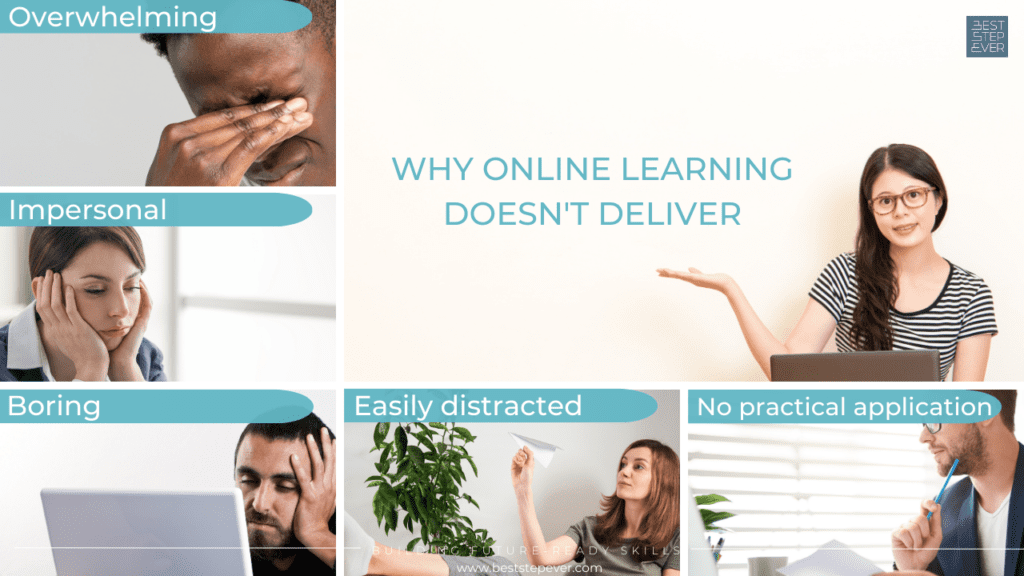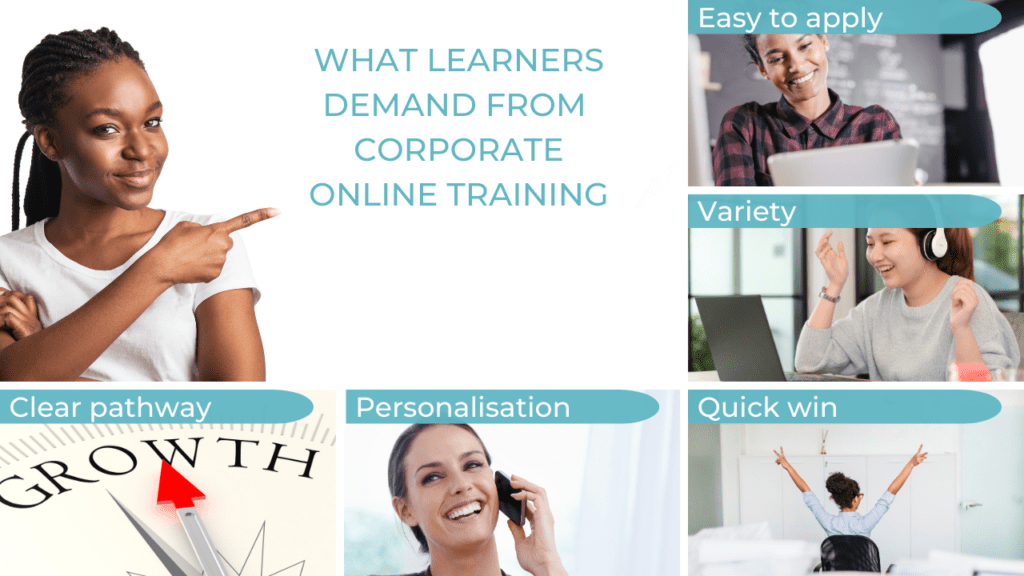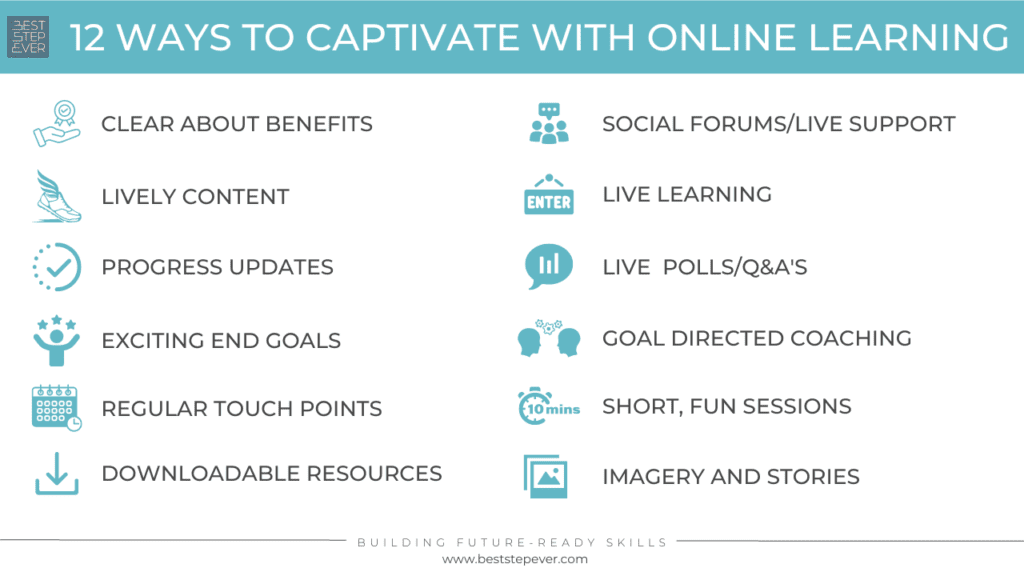If you’re experiencing low completion rates for your online learning offerings, chances are high that it’s just not what your employees want. You’re not hitting the right notes. It’s probably over-engineered and boring as &*(^@#.
Sure, you’re doing what all the other companies are doing. But guess what, they’re having the same results. They’re just not telling you.
Problem is, you’ve spent a lot of money on this. And your budget is now blown for the rest of the year. You probably feel it’s career suicide to admit that you have a very big problem.
Let’s examine what’s going wrong. And find ways to fix it.
Five reasons why online learning sucks.
There are plenty of reasons why online learning just doesn’t deliver. Here are our top five. Would you agree with this list?

1. Overwhelm
So, there it is: your employees have been given unlimited access to LinkedIn Learning, or Udemy, or Coursera or internal programs or whatever. And you may give some broad guidelines or learning paths how they can go about choosing what to dive into first.
Problem is, no-one’s doing any diving. They may be dipping a toe into the water here and there, but they’re not swimming to the other side.
You’ve given them an extremely large lake to swim in but what’s missing are the swim routes. They lack guidance to decide where to swim, why, and what the other side will look like once they get there.
Now LinkedIn Learning and all the others have some amazing courses. They also have some duds. What’s difficult is to sift out what can serve you best. The choice is too large, and the guidance is not sufficient.
2. Impersonal
Most online learning is generic in nature. One size fits all.
And that doesn’t make it engaging for learners. They feel like they’re entering a giant sausage machine, along with a whole lot of other sausages. And the chief sausage isn’t particularly interested in what they learn or how they learn. If the chief sausage wants anything out of this, it’s to know that the course or program was successfully completed. That’s mostly it.
But learning should be personally relevant. Learners need to know what’s in it for them, personally, to get the most out of the experience. And they should be able to match the learning to their unique growth path.
Learners are constantly asking themselves, “How does this benefit me, personally? Why am I doing this?”. And if the answer is not apparent, the chance of the learner disconnecting is very high.
3. Boring
Let’s face it. Most online learning is soporific. Which is a fancy word for saying that it puts you to sleep.
Mostly it’s too long. Too much waffle. You find yourself fighting to stay awake.
And the trainers tend to assume that everyone is as excited about their topic as they are. That’s a dangerous assumption to make.
Often the content is very dense. Way too much information, presented in unnecessarily convoluted ways. After being thrown with the third concept or framework or fact in as many seconds, no wonder our brains time out.
And even when some variety is thrown into the mix, or some gamification, mostly it’s a case of too little, too late. It seems like an afterthought. Because it was.
4. Too easy to get distracted
Online learning requires a lot of discipline. And most of us fail that test.
So, because we’re not captivated by the content or the presenter, we switch off. We look for other things to do.
Perhaps we start doing other work. Or catching up with social media. Or rearranging our desks. Or even leaving the room to do more pressing stuff elsewhere – like raid the fridge.
If online learning is not meaningful, interesting, or enthralling, we’re unlikely to stay on track. We’ll do the bare minimum required of us and then we’ll move onto other more relevant stuff.
5. Lacks practical application
We usually size up the content of an online learning session extremely quickly. And the criteria we use to reach a conclusion is very simple.
The critical questions we ask ourselves are, “How is this useful to me? How can I apply it and how will it benefit me to apply this?”.
And if the answer isn’t immediately apparent, we switch off. Very quickly.
Adult learning theory tells us that adults learn differently to children. They need context and application. The learning needs to be personally relevant and most importantly, it needs to apply to the daily life of the learner.
Which means that if whatever it is that we’re learning is not useful to use in an immediate, practical sense, we’re unlikely to see things through.
And much online learning content fails the test of practical application. Or else it makes it too hard for the learner to apply the learning in a quick and easy manner.
Sadly, this depressing list is all too familiar. Have you personally experienced any of these above?
Five things learners demand from their corporate online training
Now that we've identified what turns learners off, let's turn it on its head. Let's look at what sparks engagement and makes online learning a whole lot livelier.

1. Clear pathway
When we’re on a learning path, we want to know where it’s heading. What’s the map? What are the main roads and the side roads? And how does it add value to the learner?
Much as we like the sound of terms like “self-directed learning” and “personal accountability for learning,” reality is a bit different. Most learners need some form of guidance to decide what path to take first and why.
Otherwise, the novelty of endless training content soon wears off. And decision fatigue sets in.
The best learning solutions provide a clear roadmap to get the learner from A to Z, using manageable chunks of learning to get them there. And it should be clear to the learner at all stages how far they are, and how far they need to go.
2. Personalisation
Learners need their corporate training to benefit themselves as well as the company. What’s in it for them? If the training objectives don’t provide a personal benefit, this is highly likely to negatively impact the learning outcomes.
To be effective, corporate training needs to make it clear how the individual benefits. How will new skills and knowledge be of direct benefit to them?
And what opportunities do learners have to customize and shape their training to their personal benefit? Ensuring that the content has personal relevance and adds meaning to their world will ensure learners complete the program and reap the benefits. And that’s a clear win/win for both parties.
3. Easy to understand and apply
Today’s workplace is fast and furious. No-one has time to add more complexity to their life. It’s already volatile and ambiguous enough, thank you very much.
This means that online learning needs to be clear and focused from the start. What’s the key message? Why is it important? And how can the learner apply it as quickly as possible to see how it may benefit them?
These questions have major implications for learning design and delivery. The online training product should have sharp delivery and clear messaging if you want your learners to engage and grow.
Bridging the knowing/doing gap (“ok, now I understand what I should be doing but how the heck do I put this into practice in my daily job”) should be built into the learning design. Learners want practical ways to put the learning into practice and to see potential benefits, fast.
4. Variety
Now for the somewhat tricky bit. Making online learning fun and interesting so that learners stay engaged. Which is tough, because they have so many other things competing for their attention at any one time.
Variety is the name of the game here. Variety in delivery (video, audio, bold graphics, multiple presenters with different styles etc.) as well as lots of different and creative activities (not just filling in worksheets, please; how about quizzes, puzzles, case studies, demonstrations etc.) play a huge role in learner engagement and lesson retention.
The learning formula needs to change constantly to keep the learner on their toes and interested in finding out what happens next. If it’s predictable, it’s probably not going to work for long.
5. Quick win
We live in an age of quick decisions and many options. If the first thing we try doesn’t meet our expectations, we go elsewhere. Because we can.
And the same applies to online learning. Learners only stick with something if the pain is worth the gain. Otherwise, they’ll find plenty of reasons to drop out of the course, or program.
One way to mitigate this is to provide a quick win. If the learner learns something very useful early on, or has a powerful “aha!” insight moment, or if they’re able to solve a problem they’re currently tackling, they’re much more likely to stay engaged. Because now they’re waiting for the next magic moment.
Designing a learning path which delivers an early quick win, followed by plenty of other quick wins along the way, will succeed in keeping their learners motivated and engaged.
Does the learning you provide deliver on these five key aspects to create inspired and self-driven learners?
12 Ways to captivate your audience with online learning
Learning in an online environment has its challenges. It’s very hard to get it right. Here are 12 ways to liven up an online environment and make it more learner centric.

1. Be clear about the benefits
How exactly is the learner going to benefit from the training? Not the company, but the individual. What’s in it for them? You need to have a clear value proposition that’s going to hook them in and keep them engaged for the duration of the program. And it needs to be something that’s meaningful on a personal level.
It’s important to spell this out upfront. In flashing lights!
2. Lively content
We’ve all experienced death by Powerpoint. That’s why we’re running in the opposite direction.
Good online learning is lively, interesting, and stimulating. It takes the learner on a memorable and exciting journey to a predetermined destination.
Ways to create lively content is to ensure that a variety of teaching methods are being used in novel ways. This may involve a text, a video, a live presenter, a quiz, gamification etc. What’s important is that the format varies and creates excitement – because no-one can guess what’s coming next. And it’s that variety that keeps people hooked, and learning, because it’s anything but boring.
3. Clear idea of progress
As a learner, we need to know how long the road is, or how high the mountain is, before we commit to the journey. Otherwise, it feels like an impossible mission. And it’s the same with online learning.
The learning journey needs to give constant updates of how far the learner is. Preferably with some encouragement.
It’s good to know that you’ve reached x stage or have completed 53% of the path. Feedback on progress to date is a very important part of keeping the learning on track and stimulated.
4. Exciting end goal
We all like to know where we’re heading, and if the end point is worth the journey.
And it’s exactly the same for online learning. What’s the end goal? And is it an exciting one for the learners? If not, time to head back to the drawing board and work on that user experience.
Every learning journey needs to have a worthwhile end point. One in which the learner says, “That was worth the time I spent on it. I’m glad I got here, and I feel I’ve benefitted enormously”.
5. Regular touch points
Are there regular points during the learning journey when the online learning interacts with the learner in a personal way? This may include feedback on progress, a quick poll or questionnaire to evaluate learner satisfaction, an achievement award, a teaser for what’s to come and how it’s relevant to the learner, etc.
6. Downloadable resources
Much value can be created for learners through downloadable resources that they can keep and refer back to long after they’ve completed their online course.
Examples of such resources may include course summaries, activities, supplementary learning, or templates. The main focus is to add value to the learning journey through access to additional resources.
7. Live chat & social forums
Online learning is often seen as lonely and isolating. This can be addressed through providing live chat opportunities for learners to clarify their understanding or to ask questions. However, there’s a warning – using simplistic bots will undermine the credibility of the chat benefit. Far better to have a real live person with the right knowledge readily available to support the learner.
Social forums are a great way to connect learners to each other along the learning journey and promote inclusivity. Some caveats exist here as well: social forums need moderation to ensure interactions remain positive and relevant; and sometimes learners are cautious about exposing their perceived weaknesses. Nevertheless, once trust is built up, a social forum can make online learning a more interactive and engaging process.
8. Blended learning
Online learning can be livened up and given a stronger “face” by interspersing the online content with live learnings. Traditionally, blended learning referred to interspersing online learning with face-to-face contact in the training room. Since the pandemic, live learnings have also gone online, but the interaction is in “real time”.
Regular instructor-led sessions allow learners to interact with a real live instructor, engage more deeply with the content, and get the clarity and focus they may need.
9. Live polls /Q &A’s
Who doesn’t like to give their opinion? That’s why live polls can do a lot to stimulate learner interest and provide valuable feedback on learner opinions and preferences. Anonymizing the responses can allow learners to test their knowledge in a safe environment and learn from the responses of others.
Question and answer sessions led by an instructor are extremely useful to the learner in allowing them to deepen their understanding of the topic at hand. As learners engage with the online content, they can be encouraged to gather their questions in advance of an upcoming Q&A session.
10. Goal-directed coaching
Supplementing online learning with short, snappy coaching sessions aimed specifically at getting the most out of the topic at hand is gaining popularity. These coaching sessions are mostly done individually or in small groups. The coaching is aimed at a very specific goal: to enable the learner to accelerate their progress and understanding.
Not surprisingly, it’s very popular with learners due to the high-touch, personalized nature of the coaching support.
11. Keep sessions short and fun
Learner engagement is tough. There’s so much competing for their attention.
The shorter and more fun online sessions are, the more likely the learner is to complete the program. And that’s why micro-learning is enjoying such a surge in popularity. It’s well fitted to the time-pressured, attention-deficient learners of today.
Why spend hours or a day learning about a topic if you can do it in a short, sharp, focused burst?
Don’t be fooled, however. Experienced instructional designers of micro-learning will tell you that it’s just as, if not more, time-consuming to design a micro-learning program than a more traditional program. Condensing complex concepts into smart, bite-sized pieces that pace the learning is not easy to get right. But when it works, wow, does it work!
12. Strong imagery and stories
Images stay in our minds long after the words are forgotten. That’s why the use of tools like diagrams, infographics, images etc. help to support and summarise the learning at hand. The more powerful and memorable they are, the more likely we are to recall them – sometimes years after we first had exposure to them.
And the same with storytelling. We’re very likely to forget boring facts. However, when we’re told a story that stimulates our curiosity and imagination, we’ll remember that story for a long time. And the story will help us to remember the facts or the moral of the story.
That’s why the best learning journeys include powerful imagery and captivating stories.
How does your online learning – internal or external - stack up to these twelve ways of stimulating learner engagement and involvement?



